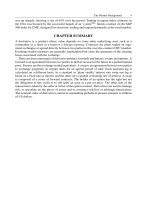Derivatives essentials an introduction to forwards, futures, options and swaps
Bạn đang xem bản rút gọn của tài liệu. Xem và tải ngay bản đầy đủ của tài liệu tại đây (7.83 MB, 366 trang )
Table of Contents
Preface
Acknowledgments
About the Author
Part One: Introduction to Forwards, Futures, and Options
Chapter 1: Forwards and Futures
Introduction
1.1 Forward contract characteristics
1.2 Long forward payoff
1.3 Long forward P&L
1.4 Short forward payoff
1.5 Short forward P&L
1.6 Long forward P&L diagram
1.7 Short forward P&L diagram
1.8 Forwards are zero-sum games
1.9 Counterparty credit risk
1.10 Futures contracts
Key Points
Chapter 2: Call Options
Introduction
2.1 Call option characteristics
2.2 Long call payoff
2.3 Long call P&L
2.4 Short call payoff
2.5 Short call P&L
2.6 Long call P&L diagram
2.7 Short call P&L diagram
2.8 Call options are zero-sum games
2.9 Call option moneyness
2.10 Exercising a call option early
2.11 Comparison of call options and forwards/futures
Key Points
Chapter 3: Put Options
Introduction
3.1 Put option characteristics
3.2 Long put payoff
3.3 Long put P&L
3.4 Short put payoff
3.5 Short put P&L
3.6 Long put P&L diagram
3.7 Short put P&L diagram
3.8 Put options are zero-sum games
3.9 Put option moneyness
3.10 Exercising a put option early
3.11 Comparison of put options, call options, and forwards
Key Points
Part Two: Pricing and Valuation
Chapter 4: Useful Quantitative Concepts
Introduction
4.1 Compounding conventions
4.2 Calculating future value and present value
4.3 Identifying continuously compounded interest rates
4.4 Volatility and historical standard deviation
4.5 Interpretation of standard deviation
4.6 Annualized standard deviation
4.7 The standard normal cumulative distribution function
4.8 The z-score
Key Points
Chapter 5: Introduction to Pricing and Valuation
Introduction
5.1 The concepts of price and value of a forward contract
5.2 The concepts of price and value of an option
5.3 Comparison of price and value concepts for forwards and options
5.4 Forward value
5.5 Forward price
5.6 Option value: The Black-Scholes model
5.7 Calculating the Black-Scholes model
5.8 Black-Scholes model assumptions
5.9 Implied volatility
Key Points
Chapter 6: Understanding Pricing and Valuation
Introduction
6.1 Review of payoff, price, and value equations
6.2 Value as the present value of expected payoff
6.3 Risk-neutral valuation
6.4 Probability and expected value concepts
6.5 Understanding the Black-Scholes equation for call value
6.6 Understanding the Black-Scholes equation for put value
6.7 Understanding the equation for forward value
6.8 Understanding the equation for forward price
Key Points
Chapter 7: The Binomial Option Pricing Model
Introduction
7.1 Modeling discrete points in time
7.2 Introduction to the one-period binomial option pricing model
7.3 Option valuation, one-period binomial option pricing model
7.4 Two-period binomial option pricing model, European-style option
7.5 Two-period binomial model, American-style option
7.6 Multi-period binomial option pricing models
Key Points
Part Three: The Greeks
Chapter 8: Introduction to the Greeks
Introduction
8.1 Definitions of the Greeks
8.2 Characteristics of the Greeks
8.3 Equations for the Greeks
8.4 Calculating the Greeks
8.5 Interpreting the Greeks
8.6 The accuracy of the Greeks
Key Points
Chapter 9: Understanding Delta and Gamma
Introduction
9.1 Describing sensitivity using Delta and Gamma
9.2 Understanding Delta
9.3 Delta across the underlying asset price
9.4 Understanding Gamma
9.5 Gamma across the underlying asset price
Key Points
Chapter 10: Understanding Vega, Rho, and Theta
Introduction
10.1 Describing sensitivity using Vega, Rho, and Theta
10.2 Understanding Vega
10.3 Understanding Rho
10.4 Understanding Theta
Key Points
Part Four: Trading Strategies
Chapter 11: Price and Volatility Trading Strategies
Introduction
11.1 Price and volatility views
11.2 Relating price and volatility views to Delta and Vega
11.3 Using forwards, calls, and puts to monetize views
11.4 Introduction to straddles
11.5 Delta and Vega characteristics of long and short straddles
11.6 The ATM DNS strike price
11.7 Straddle: numerical example
11.8 P&L diagrams for long and short straddles
11.9 Breakeven points for long and short straddles
11.10 Introduction to strangles
11.11 P&L diagrams for long and short strangles
11.12 Breakeven points for long and short strangles
11.13 Summary of simple price and volatility trading strategies
Key Points
Chapter 12: Synthetic, Protective, and Yield-Enhancing Trading Strategies
Introduction
12.1 Introduction to put-call parity and synthetic positions
12.2 P&L diagrams of synthetic positions
12.3 Synthetic positions premiums and ATMF
12.4 The Greeks of synthetic positions
12.5 Option arbitrage
12.6 Protective puts
12.7 Covered calls
12.8 Collars
Key Points
Chapter 13: Spread Trading Strategies
Introduction
13.1 Bull and bear spreads using calls
13.2 Bull and bear spreads using puts
13.3 Risk reversals
13.4 Butterfly spreads
13.5 Condor spreads
Key Points
Part Five: Swaps
Chapter 14: Interest Rate Swaps
Introduction
14.1 Interest rate swap characteristics
14.2 Interest rate swap cash flows
14.3 Calculating interest rate swap cash flows
14.4 How interest rate swaps can transform cash flows
Key Points
Chapter 15: Credit Default Swaps, Cross-Currency Swaps, and Other Swaps
Introduction
15.1 Credit default swap characteristics
15.2 Key determinants of the credit default swap spread
15.3 Cross-currency swap characteristics
15.4 Transforming cash flows using a cross-currency swap
15.5 Other swap varieties
Key Points
Appendix: Solutions to Knowledge Check Questions
A.1 Chapter 1: Forwards and Futures
A.2 Chapter 2: Call Options
A.3 Chapter 3: Put Options
A.4 Chapter 4: Useful Quantitative Concepts
A.5 Chapter 5: Introduction to Pricing and Valuation
A.6 Chapter 6: Understanding Pricing and Valuation
A.7 Chapter 7: The Binomial Option Pricing Model
A.8 Chapter 8: Introduction to the Greeks
A.9 Chapter 9: Understanding Delta and Gamma
A.10 Chapter 10: Understanding Vega, Rho, and Theta
A.11 Chapter 11: Price and Volatility Trading Strategies
A.12 Chapter 12: Synthetic, Protective, and Yield-Enhancing Trading Strategies
A.13 Chapter 13: Spread Trading Strategies
A.14 Chapter 14: Interest Rate Swaps
A.15 Chapter 15: Credit Default Swaps, Cross-Currency Swaps, and Other Swaps
Index
End User License Agreement
List of Illustrations
Chapter 1: Forwards and Futures
Figure 1.1 Forward contract cash flows
Figure 1.2 Forward contract cash flows example
Figure 1.3 Forward contract cash flows example
Figure 1.4 Long forward payoff example
Figure 1.5 Long forward P&L example
Figure 1.6 Short forward payoff example
Figure 1.7 Short forward P&L example
Figure 1.8 Long forward P&L diagram
Figure 1.9 Long forward P&L diagram
Figure 1.10 Short forward P&L diagram
Figure 1.11 Short forward P&L diagram
Figure 1.12 Forward contract as a zero-sum game
Chapter 2: Call Options
Figure 2.1 European-style call option cash flows
Figure 2.2 European-style call option cash flows example
Figure 2.3 Long call P&L diagram
Figure 2.4 Long call P&L diagram example
Figure 2.5 Short call P&L diagram
Figure 2.6 Short call P&L diagram
Figure 2.7 Call option as a zero-sum game
Chapter 3: Put Options
Figure 3.1 European-style put option cash flows
Figure 3.2 European-style put option cash flows example
Figure 3.3 Long put P&L diagram
Figure 3.4 Long put P&L diagram example
Figure 3.5 Short put P&L diagram
Figure 3.6 Short put P&L diagram example
Figure 3.7 Put option as a zero-sum game
Chapter 4: Useful Quantitative Concepts
Figure 4.1 Growth of an investment that receives 5% over one year
Figure 4.2 Growth of an investment that receives 2.5% for two six-month periods
Figure 4.3 Probability of return above or below the average return
Figure 4.4 Probability of return within one standard deviation of the average return
Figure 4.5 Probability of return within two standard deviations of the average
return
Figure 4.6 Probability of return within three standard deviations of the average
return
Chapter 5: Introduction to Pricing and Valuation
Figure 5.1 Volatility term structure example
Figure 5.2 Volatility smile example
Figure 5.3 Volatility skew example
Figure 5.4 Volatility surface example
Chapter 7: The Binomial Option Pricing Model
Figure 7.1 Discrete points in time in one-, two-, three-, and four-period models
Figure 7.2 Characteristics of the underlying asset, one-period binomial model
Figure 7.3 Underlying asset example, one-period binomial model
Figure 7.4 Characteristics of a call option, one-period binomial model
Figure 7.5 Call option example, one-period binomial model
Figure 7.6 Cost and payoffs associated with a portfolio consisting of α of the
underlying asset and a short call
Figure 7.7 Cost and payoffs example associated with a portfolio consisting of α of
the underlying asset and a short call
Figure 7.8 Underlying asset example, two-period binomial model
Figure 7.9 European-style put option example, two-period binomial model
Figure 7.10 Midpoint node valuation, European-style put option example, twoperiod binomial model
Figure 7.11 Option valuation, European-style put option example, two-period
binomial model
Figure 7.12 Option valuation, American-style put option example, two-period
binomial model
Chapter 9: Understanding Delta and Gamma
Figure 9.1 Delta across the underlying asset price for long and short calls and puts
Figure 9.2 Gamma across the underlying asset price for long and short calls and
puts
Chapter 10: Understanding Vega, Rho, and Theta
Figure 10.1 The symmetrical sensitivity of forward positions
Figure 10.2 The asymmetrical sensitivity of long calls and puts
Figure 10.3 The asymmetrical sensitivity of short calls and puts
Figure 10.4 Examples of long call and put values across time to expiration
Chapter 11: Price and Volatility Trading Strategies
Figure 11.1 Long and short straddles' P&L diagrams
Figure 11.2 Long and short strangles' P&L diagrams
Chapter 12: Synthetic, Protective, and Yield-Enhancing Trading Strategies
Figure 12.1 P&L diagrams for long and short synthetic forwards
Figure 12.2 P&L diagrams for long and short synthetic calls
Figure 12.3 P&L diagrams for long and short synthetic puts
Figure 12.4 P&L diagram for a collar
Chapter 13: Spread Trading Strategies
Figure 13.1 P&L diagrams for bull and bear spreads using calls
Figure 13.2 P&L diagrams for bull and bear spreads using puts
Figure 13.3 P&L diagram for a risk reversal
Figure 13.4 P&L diagrams for long and short butterfly spreads
Figure 13.5 P&L diagrams for long and short condor spreads
Chapter 14: Interest Rate Swaps
Figure 14.1 The exchange of fixed rate for floating rate in an interest rate swap
Figure 14.2 Floating rate borrower
Figure 14.3 Transformation of floating rate borrowing into fixed rate borrowing
Figure 14.4 Floating rate lender
Figure 14.5 Transformation of floating rate lending into fixed rate lending
Figure 14.6 Fixed rate borrower
Figure 14.7 Transformation of fixed rate borrowing into floating rate borrowing
Figure 14.8 Fixed rate lender
Figure 14.9 Transformation of a fixed rate lending into floating rate lending
Chapter 15: Credit Default Swaps, Cross-Currency Swaps, and Other Swaps
Figure 15.1 GBP borrower
Figure 15.2 Transformation of GBP borrowing into EUR borrowing: detailed cash
flows
Figure 15.3 Transformation of GBP borrowing into EUR borrowing: net cash flows
List of Tables
Chapter 2: Call Options
Table 2.1 Call option exercise decision and long call payoff
Table 2.2 Call option exercise decision and long call payoff and P&L
Table 2.3 Call option exercise decision and short call payoff
Table 2.4 Call option exercise decision and short call payoff and P&L
Table 2.5 Long and short call P&L and net P&L
Table 2.6 Call option moneyness and long and short call payoff
Table 2.7 Comparison of forwards/futures and call option positions
Chapter 3: Put Options
Table 3.1 Put option exercise decision and long put payoff
Table 3.2 Put option exercise decision and long put payoff and P&L
Table 3.3 Put option exercise decision and short put payoff
Table 3.4 Put option exercise decision and short put payoff and P&L
Table 3.5 Long and short put P&L and net P&L
Table 3.6 Put option moneyness and long and short put payoff
Table 3.7 Comparison of forwards/futures, call option, and put option positions
Chapter 4: Useful Quantitative Concepts
Table 4.1 15-day sample
Table 4.2 Calculation of historical standard deviation
Chapter 5: Introduction to Pricing and Valuation
Table 5.1 Comparison of price and value concepts for forwards and options
Table 5.2 Option value calculation process
Table 5.3 Option value as the output of the Black-Scholes model
Table 5.4 Implied volatility as the output of the reverse-engineered Black-Scholes
model
Chapter 6: Understanding Pricing and Valuation
Table 6.1 Learning objectives of each section of this chapter
Table 6.2 Review of payoff, price, and value equations
Table 6.3 Interest rate demanded as a function of the investor type and investment
opportunity
Table 6.4 Probability and expected value concepts
Table 6.5 Interpretation of long call value
Table 6.6 Interpretation of long put value
Table 6.7 Interpretation of long forward value
Chapter 8: Introduction to the Greeks
Table 8.1 The Greeks as measures of sensitivity
Table 8.2 Source of sensitivity for each of the Greeks
Table 8.3 Equations for the Greeks
Table 8.4 Calculations of position value and the Greeks, long call example
Table 8.5 Summary of position value and Greeks, long call example
Table 8.6 Comparison of the Greeks to Black-Scholes model estimated changes
Chapter 9: Understanding Delta and Gamma
Table 9.1 Describing sensitivity using Delta and Gamma
Table 9.2 Delta and Gamma of forwards and options
Table 9.3 Example of Delta and Gamma for long and short forward and option
positions
Table 9.4 The purchasing and selling counterparties in a forward, call, and put
Table 9.5 Delta across the underlying asset price
Table 9.6 Why Gamma is long, short, or neutral for each position
Table 9.7 Gamma across underlying asset prices
Chapter 10: Understanding Vega, Rho, and Theta
Table 10.1 Describing sensitivity using Vega, Rho, and Theta
Table 10.2 The Greeks of forwards and options
Table 10.3 Example of the Greeks for long and short forward and option positions
Table 10.4 The net impact of decreases in time to expiration
Chapter 11: Price and Volatility Trading Strategies
Table 11.1 Sensitivities and Greek positions that monetize price and volatility views
Table 11.2 Targeted Greek positions as function of price and volatility view
combination
Table 11.3 Delta and Vega of forwards and options
Table 11.4 Forward and option positions that monetize price and volatility view
combinations
Table 11.5 The Delta and Vega characteristics of long and short straddles
Table 11.6 ATM and ATM DNS
Table 11.7 Example of long straddle premiums, Delta and Vega
Table 11.8 Example of long straddle sensitivity
Table 11.9 Trading strategies through which to monetize price and volatility view
combinations
Chapter 12: Synthetic, Protective, and Yield-Enhancing Trading Strategies
Table 12.1 Synthetic positions
Table 12.2 ATM, ATMF, and ATM DNS
Table 12.3 Option arbitrage
Chapter 14: Interest Rate Swaps
Table 14.1 The impact of the future level of LIBOR for interest rate swap
counterparties
Table 14.2 LIBOR observations
Table 14.3 Calculation of floating leg payments
Table 14.4 Calculation of fixed leg payments
Table 14.5 Calculation of net cash flows
Table 14.6 Comparison of cash flow transformation strategies using interest rate
swaps
Chapter 15: Credit Default Swaps, Cross-Currency Swaps, and Other Swaps
Table 15.1 Credit default swap sensitivity
Table 15.2 Exposure transformation strategies using credit default swaps
The Wiley Finance series contains books written specifically for finance and investment
professionals as well as sophisticated individual investors and their financial advisors.
Book topics range from portfolio management to e-commerce, risk management,
financial engineering, valuation and financial instrument analysis, as well as much more.
For a list of available titles, visit our Web site at www.WileyFinance.com
Founded in 1807, John Wiley & Sons is the oldest independent publishing company in the
United States. With offices in North America, Europe, Australia and Asia, Wiley is globally
committed to developing and marketing print and electronic products and services for our
customers' professional and personal knowledge and understanding.
Derivatives Essentials
An Introduction to Forwards,
Futures, Options, and Swaps
ARON GOTTESMAN
Copyright © 2016 by Aron Gottesman. All rights reserved.
Published by John Wiley & Sons, Inc., Hoboken, New Jersey.
Published simultaneously in Canada.
No part of this publication may be reproduced, stored in a retrieval system, or transmitted in any form or by any means,
electronic, mechanical, photocopying, recording, scanning, or otherwise, except as permitted under Section 107 or 108 of
the 1976 United States Copyright Act, without either the prior written permission of the Publisher, or authorization
through payment of the appropriate per-copy fee to the Copyright Clearance Center, Inc., 222 Rosewood Drive, Danvers,
MA 01923, (978) 750-8400, fax (978) 646-8600, or on the Web at www.copyright.com. Requests to the Publisher for
permission should be addressed to the Permissions Department, John Wiley & Sons, Inc., 111 River Street, Hoboken, NJ
07030, (201) 748-6011, fax (201) 748-6008, or online at />Limit of Liability/Disclaimer of Warranty: While the publisher and author have used their best efforts in preparing this
book, they make no representations or warranties with respect to the accuracy or completeness of the contents of this
book and specifically disclaim any implied warranties of merchantability or fitness for a particular purpose. No warranty
may be created or extended by sales representatives or written sales materials. The advice and strategies contained herein
may not be suitable for your situation. Y ou should consult with a professional where appropriate. Neither the publisher
nor author shall be liable for any loss of profit or any other commercial damages, including but not limited to special,
incidental, consequential, or other damages.
For general information on our other products and services or for technical support, please contact our Customer Care
Department within the United States at (800) 762-2974, outside the United States at (317) 572-3993 or fax (317) 5724002.
Wiley publishes in a variety of print and electronic formats and by print-on-demand. Some material included with
standard print versions of this book may not be included in e-books or in print-on-demand. If this book refers to media
such as a CD or DVD that is not included in the version you purchased, you may download this material at
. For more information about Wiley products, visit www.wiley.com.
Library of Congress Cataloging-in-Publication Data
Names: Gottesman, Aron A., author.
Title: Derivatives essentials : An introduction to forwards, futures, options and swaps / Aron Gottesman.
Description: Hoboken : Wiley, 2016. | Series: Wiley finance | Includes index.
Identifiers: LCCN 2016014397 (print) | LCCN 2016016290 (ebook) | ISBN 9781119163497 (hardback) | ISBN
9781119163572 (ePDF) | ISBN 9781119163565 (ePub)
Subjects: LCSH: Derivative securities.
Classification: LCC HG6024.A3 G68 2016 (print) | LCC HG6024.A3 (ebook) | DDC 332.64/57—dc23
LC record available at />Cover Image: © hywards/Shutterstock
Cover design: Wiley
For my wife Ronit and our children
Libby, Yakov, Raphi, Tzipora, and Kayla
Preface
This book provides an in-depth introduction to derivative securities. A derivative security
is an agreement between two counterparties whose payoff depends on the value of an
underlying asset. There is extensive interest in derivative securities due to their
usefulness as tools through which investors can monetize views and transform
exposures. Yet many that pursue an understanding of derivative securities can be
frustrated with educational material that assumes the learner has sophisticated
quantitative skills. Further, those with sophisticated quantitative skills can be frustrated
with educational material that derives equations with little insight into the economic
nature of derivative securities products and strategies.
This book focuses on helping you develop a meaningful understanding of derivative
securities products and strategies and how to communicate your understanding both
conceptually as well as through equations. You will learn about each product and strategy
and the reasons for investing in them. You will learn about quantitative pricing and
valuation models and will develop a deep understanding as to why the models represent
price and value. You will learn of the great importance of the sensitivity measures known
as the “Greeks” and learn how to use them to understand and characterize products and
strategies.
Quantitative modeling is an important element of derivative securities, and this book will
present quantitative models. However, this book does not assume that you have
sophisticated quantitative or finance skills beyond the ability to add, subtract, multiply,
divide, raise to a power, and rudimentary familiarity with time value of money concepts.
Any other quantitative concept that is required to understand the material in this book
will be introduced before it is required. Further, this book does not intend to provide
comprehensive mathematical derivations nor provide quantitative overviews of each of
the myriad of derivative securities variations in existence. Instead, the quantitative
analysis in this book focuses on several key products through which we will explore
conceptual and quantitative insights that are broadly applicable to other products and,
most importantly, enable you to verbally communicate a deep understanding of products
and strategies.
There are five parts to this book:
Part One: Introduction to Forwards, Futures, and Options (Chapters 1–3)
Part Two: Pricing and Valuation (Chapters 4–7)
Part Three: The Greeks (Chapters 8–10)
Part Four: Trading Strategies (Chapters 11–13)
Part Five: Swaps (Chapters 14–15)
Part One introduces forwards, futures, and options. Forwards and futures are agreements
that obligate counterparties to transact in the future. Options are agreements that provide
one of the counterparties a right, and not an obligation, to transact in the future. In Part
One you will learn about the key characteristics of forwards, futures, and options and
each position's cash flows, payoffs, and P&L (profit and loss). You will also learn why
forwards, futures, and options are described as zero-sum games and the concepts of
moneyness and counterparty credit risk.
Part Two explores pricing and valuation of forwards and options. In Part Two you will
learn to distinguish between price and value and explore models of price and value for
each position, including the Black-Scholes and binomial option pricing models. You will
also learn about the assumptions that these models make, risk-neutral valuation, and
why the models represent price and value. You will also be introduced to the concepts of
implied volatility and volatility surfaces.
Part Three explores the “Greeks,” which are measures of product and strategy sensitivity
to change in the determinants of their value. In Part Three you will learn how to define,
calculate, and interpret the Greeks and why they can be inaccurate. You will also develop
a deep understanding of how the Greeks can be used to understand and describe
sensitivity; why a given Greek will be positive, negative, or zero; and why its magnitude
can change.
Part Four explores trading strategies. In Part Four you will learn how to describe and
implement price and volatility trading strategies, create synthetic positions, and
implement protective, yield enhancing, and spread trading strategies. The trading
strategies that will be explored in Part Four include straddles, strangles, protective puts,
covered calls, collars, bull spreads, bear spreads, risk reversals, butterfly spreads, and
condor spreads, among others. You will also learn advanced concepts related to
moneyness and put-call parity.
Part Five introduces swaps. A swap is an exchange of cash flows between two
counterparties over a number of periods of time. In an interest rate swap the
counterparties exchange fixed and floating interest rates. In a credit default swap periodic
payments of spread are exchanged for a payment contingent on a credit event. In a crosscurrency swap the counterparties exchange interest payments in different currencies. In
Part Five you will learn about the key characteristics of these swaps, their sensitivities
and cash flows, and how they can be used to transform exposures.
Most of the chapters in this book build on the material in previous chapters. It is
therefore important that you truly understand each chapter before advancing to the next.
To allow you to test your understanding, there are more than 650 Knowledge check
questions throughout the book, the solutions to which are provided in the appendix. The
Knowledge check questions can be used to ensure absorption of the material both when
you learn the material for the first time and also when you review.
I hope this book provides you with a deep understanding of derivative securities and an
enjoyable and valuable learning experience!
Acknowledgments
I want to acknowledge the contribution of Bill Falloon of John Wiley & Sons. This book
would not have been brought to completion without Bill's critical support. I also want to
acknowledge Meg Freeborn, Michael Henton, and Chaitanya Mella of Wiley, Kevin
Mirabile of Fordham University, and my colleagues at Pace University including Niso
Abuaf, Lew Altfest, Neil Braun, Arthur Centonze, Burcin Col, Ron Filante, Natalia
Gershun, Elena Goldman, Iuliana Ismailescu, Padma Kadiyala, Maurice Larraine, Sophia
Longman, Ray Lopez, Ed Mantell, Matt Morey, Jouahn Nam, Richard Ottoo, Joe Salerno,
Michael Szenberg, Carmen Urma, PV Viswanath, Tom Webster, Berry Wilson, and Kevin
Wynne. I also want to acknowledge Niall Darby, Stephen Feline, Allegra Kettelkamp, John
O'Toole, Patrick Pancoast, Carlos Remigio, Lisa Ryan, and the entire team at Intuition. I
further want to acknowledge Moshe Milevsky, Eli Prisman, and Gordon Roberts of York
University and Gady Jacoby of the University of Manitoba who helped spark my career.
Thank you to my many students from whom I've learned tremendously. Finally, thank
you to my wife Ronit, a woman of valor, and our children Libby, Yakov, Raphi, Tzipora,
and Kayla for providing so much love and support.
About the Author
Aron Gottesman is Professor of Finance and the Chair of the Department of Finance and
Economics at the Lubin School of Business at Pace University in Manhattan. He holds a
PhD in Finance, an MBA in Finance, and a BA in Psychology, all from York University. He
has published articles in academic journals including the Journal of Financial
Intermediation, Journal of Banking and Finance, Journal of Empirical Finance, and the
Journal of Financial Markets, among others, and has coauthored several books. Aron
Gottesman's research has been cited in newspapers and popular magazines, including The
Wall Street Journal, The New York Times, Forbes Magazine, and Business Week. He
teaches courses on derivative securities, financial markets, and asset management. Aron
Gottesman also presents workshops to financial institutions. His website can be accessed
at www.arongottesman.com.
Part One
Introduction to Forwards, Futures, and Options
Chapter 1
Forwards and Futures
INTRODUCTION
A derivative security is an agreement between two counterparties whose payoff depends
on the value of an underlying asset. In this chapter we will explore agreements that
obligate counterparties to transact in the future, known as forward contracts and futures
contracts.
After you read this chapter you will be able to
Describe the key characteristics of a forward.
Define and contrast the concepts of payoff and P&L.
Describe a forward's cash flows, payoff, and P&L.
Understand how equations and P&L diagrams can be used to describe a forward's cash
flows.
Understand when forwards earn profits, suffer losses, and break even.
Explain why forwards are zero-sum games.
Define counterparty credit risk and understand mechanisms through which it is
managed and minimized.
Describe futures contracts.
Compare and contrast forwards and futures.
1.1 FORWARD CONTRACT CHARACTERISTICS
A forward contract is an agreement between two counterparties that obligates them to
transact in the future. The key characteristics of a forward are as follows:
One of the counterparties is referred to as the “long position” or “long forward,” and
the other counterparty is referred to as the “short position” or “short forward.”
The long forward is obligated to purchase an asset from the short forward at a future
point in time. The short forward is obligated to sell the asset.
The asset is known as the “underlying asset.” The underlying asset can be any asset.
Common examples include stocks, bonds, currencies, and commodities.
The future point in time when the transaction occurs is known as the “expiration
date.” For example, a forward may have an expiration date that is three months after
initiation.
The price at which the underlying asset is purchased is called the “forward price.” The
forward price is set at initiation though the transaction only takes place in the future.
For example, at initiation two counterparties may agree to a forward price of $100 and
an expiration date that is in three months. The long forward is obligated to purchase
the asset from the short forward for $100 in three months.
All details are specified at initiation, including:
The counterparties
The underlying asset
The forward price
The expiration date
Hence, a forward is very similar to any transaction where an individual buys an asset
from another individual, with the interesting twist that while the purchase price is set at
initiation the transaction itself takes place at a future point in time. Figure 1.1 illustrates a
forward.
Figure 1.1 Forward contract cash flows
For example, consider the following scenario:
Initiation = July 15
Expiration = September 15
Underlying asset = one share
Forward price = $100
Figure 1.2 illustrates this example.
Figure 1.2 Forward contract cash flows example
Figure 1.2 shows that at initiation, July 15, no transaction takes place. Instead, on July 15
the long forward and short forward enter into an agreement that
Obligates the long forward to purchase a single share from the short forward on
September 15 for the forward price of $100. Hence, at expiration the long position
pays $100 and receives one share in return.
Obligates the short forward to sell a single share to the long forward on September 15
for the forward price of $100. Hence at expiration the short forward receives $100 and
delivers one share in return.
Let's consider another example:
Initiation = August 20
Expiration = December 20
Underlying asset = One ounce of gold
Forward price = $1,250
Figure 1.3 illustrates this example.
Figure 1.3 Forward contract cash flows example
Figure 1.3 shows that at initiation, August 20, no transaction takes place. However, on
August 20 the long forward and short forward enter into an agreement that
Obligates the long forward to purchase one ounce of gold from the short forward on









